Keysight Technologies Bundle
Who Really Owns Keysight Technologies?
Ever wondered about the forces shaping the future of electronic design and test solutions? Keysight Technologies, a leader in its field, has a compelling ownership story. Understanding Keysight Technologies SWOT Analysis is crucial for investors and strategists alike. This article unveils the ownership structure of Keysight, tracing its roots and impact on its market position.
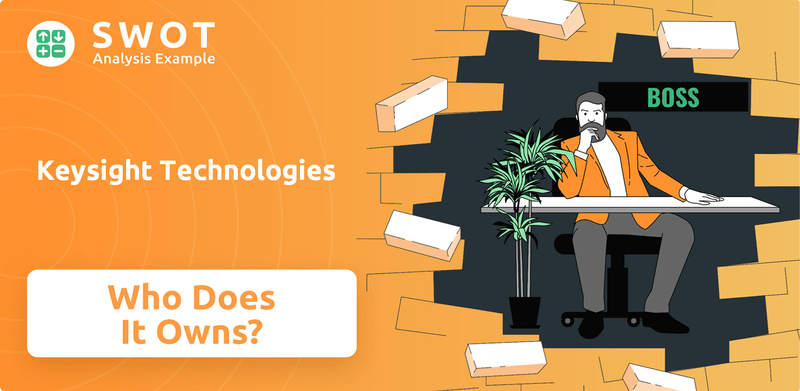
From its origins as a spin-off to its current status as a publicly traded entity, the evolution of Keysight's ownership provides crucial insights. Discover the key players, explore significant changes over time, and understand how this impacts the company's governance and strategy. Learn about the major investors in Keysight Technologies, and how this influences the company's financial performance and market share. This deep dive into Keysight ownership will help you understand if Keysight stock is a good investment.
Who Founded Keysight Technologies?
The story of Keysight Technologies' origins is unique, diverging from the typical startup narrative. It doesn't have individual founders in the conventional sense. Its roots are firmly planted in the legacy of Hewlett-Packard (HP) and Agilent Technologies.
The foundation for Keysight was laid by William R. Hewlett and David Packard, who established Hewlett-Packard in 1939. The electronic measurement business, which later became Keysight, was a spin-off from Agilent Technologies. This business unit inherited the test and measurement product lines originally developed by Hewlett-Packard.
When Agilent Technologies spun off Keysight in 2014, it was structured as a tax-free distribution of Keysight's common stock to Agilent's shareholders. This meant that Agilent shareholders received one share of Keysight for every two shares of Agilent they held as of October 22, 2014. This distribution method directly shaped the initial ownership of Keysight.
The founders of the lineage leading to Keysight are William R. Hewlett and David Packard, who started Hewlett-Packard in 1939.
Keysight was spun off from Agilent Technologies in 2014, distributing shares to Agilent shareholders.
At its inception as an independent public company on November 3, 2014, Keysight was valued at approximately $5.2 billion.
Around 167 million shares were distributed to Agilent shareholders during the spin-off.
There were no specific early backers or angel investors in the initial phase; ownership went directly to Agilent's shareholders.
Insider ownership at Keysight is relatively low, reflecting its spin-off origin.
The initial Keysight ownership structure was unique because it didn't involve traditional venture capital or angel investors. Instead, the Keysight shareholders were the existing shareholders of Agilent Technologies. As a publicly traded company from its inception, Keysight company did not have early-stage agreements common in startups. Understanding Keysight ownership is crucial for anyone interested in the company. For more insights into the business, consider exploring the Revenue Streams & Business Model of Keysight Technologies.
The founding of Keysight is rooted in the history of Hewlett-Packard and Agilent Technologies.
- Keysight was spun off from Agilent Technologies in 2014.
- Ownership was distributed to Agilent shareholders.
- No traditional early investors were involved.
- The company's initial valuation was approximately $5.2 billion.
Keysight Technologies SWOT Analysis
- Complete SWOT Breakdown
- Fully Customizable
- Editable in Excel & Word
- Professional Formatting
- Investor-Ready Format
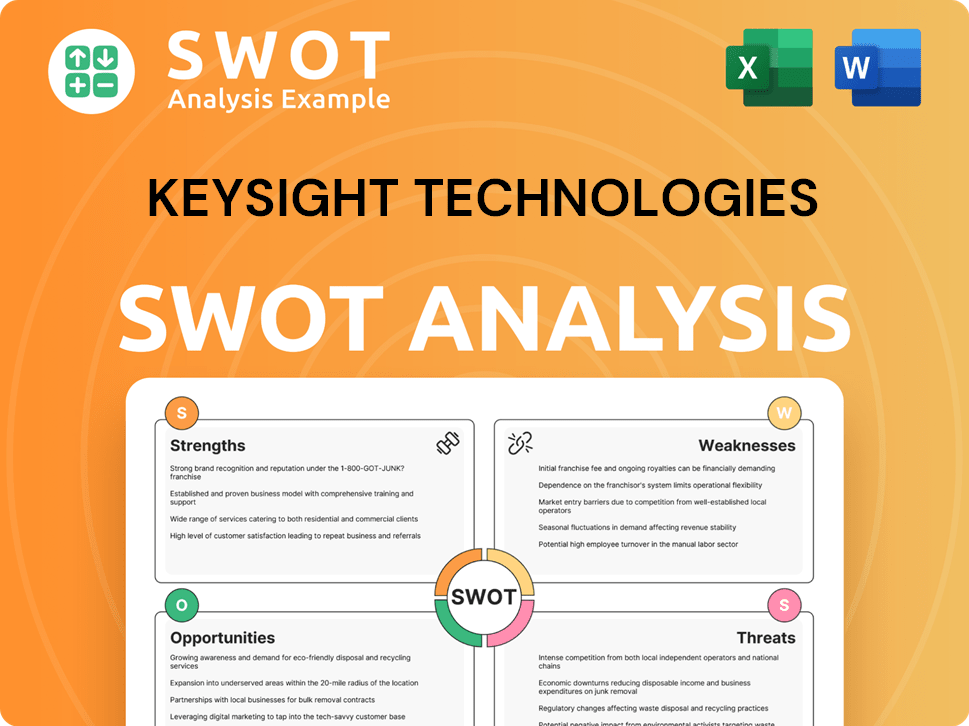
How Has Keysight Technologies’s Ownership Changed Over Time?
The ownership structure of Keysight Technologies has evolved significantly since its spin-off from Agilent Technologies in November 2014. Initially, the separation was structured as a tax-free distribution, with Agilent shareholders receiving Keysight stock. This marked the beginning of Keysight Technologies as an independent entity, trading on the NYSE under the ticker symbol KEYS, and it began with an initial market capitalization of approximately $5.2 billion.
The evolution of Keysight's ownership has been marked by a shift towards significant institutional holdings. This transition has been a key factor in shaping the company's strategic direction and governance, aligning its objectives with the interests of major, long-term investors. The high level of institutional ownership suggests strong confidence from major financial entities and can make the stock price sensitive to their trading actions.
| Metric | Details | Data |
|---|---|---|
| Initial Public Offering (IPO) | Date | November 3, 2014 |
| Initial Market Capitalization | Approximate Value | $5.2 billion |
| Institutional Ownership (December 31, 2024) | Percentage | Approximately 91.14% |
As of March 31, 2025, major institutional stakeholders include Vanguard Group Inc. (holding 12.18%), T. Rowe Price Group, Inc. (12.85%), and BlackRock, Inc. (9.22%). These top institutional holders collectively own a substantial portion of the company. The strategic acquisitions, such as the recent acquisition of Spirent, reflect a strategy aimed at capturing early positions in emerging technologies like AI and 6G, which would appeal to growth-oriented institutional investors. To learn more about the company's marketing approach, you can check the Marketing Strategy of Keysight Technologies.
Keysight Technologies is primarily owned by institutional investors, reflecting strong market confidence.
- Institutional ownership is around 73.62% as of June 5, 2025.
- Vanguard, T. Rowe Price, and BlackRock are among the largest institutional shareholders.
- The ownership structure influences Keysight's strategic decisions, such as investments in R&D and acquisitions.
- Insiders own a small percentage of the company's shares.
Keysight Technologies PESTLE Analysis
- Covers All 6 PESTLE Categories
- No Research Needed – Save Hours of Work
- Built by Experts, Trusted by Consultants
- Instant Download, Ready to Use
- 100% Editable, Fully Customizable
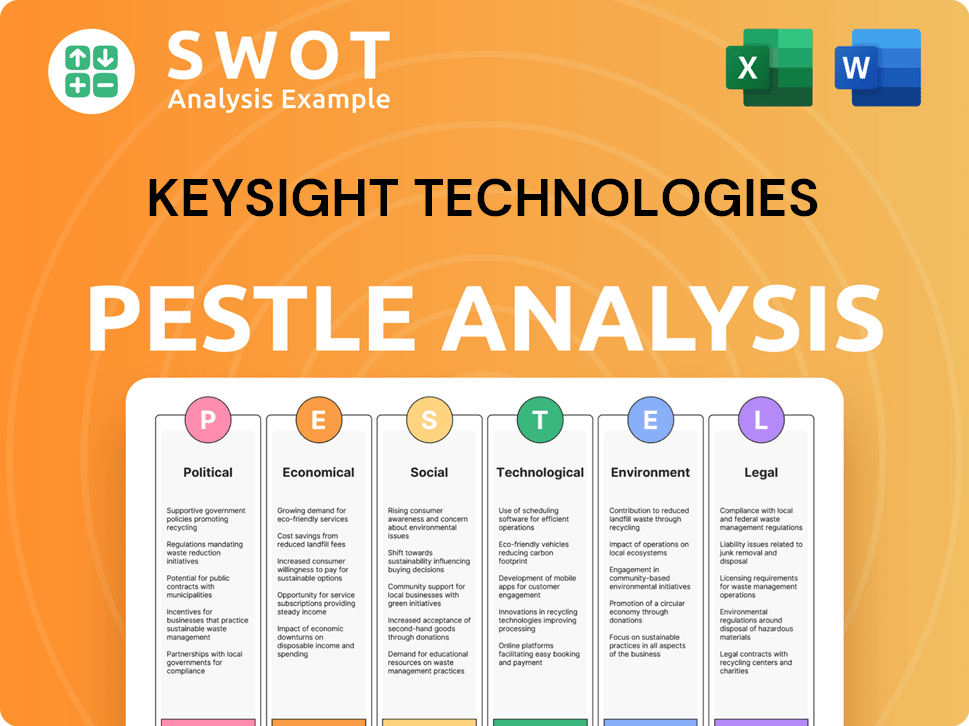
Who Sits on Keysight Technologies’s Board?
The Board of Directors at Keysight Technologies oversees the company's strategic direction and represents shareholder interests. Information regarding the specific composition of the board and individual shareholdings for 2025 is not fully available in the search results. However, the board structure of a publicly traded company like Keysight typically includes a mix of independent directors and those affiliated with major institutional investors. Understanding the board's composition is crucial for assessing corporate governance and how well it aligns with shareholder interests. The board plays a key role in decisions impacting the company's future, making it essential to understand its structure and influence.
The board's influence is significant, especially considering the substantial institutional ownership of Keysight Technologies. These large investors collectively hold a considerable amount of influence over board decisions and corporate governance. The voting power of major institutional shareholders like The Vanguard Group, Inc., T. Rowe Price Group, Inc., and BlackRock, Inc. is particularly noteworthy. The board's decisions are likely influenced by the collective concerns and proposals of these major shareholders, highlighting the importance of understanding the ownership structure when evaluating the company.
| Board Member | Title | Affiliation |
|---|---|---|
| Not Available | Not Available | Not Available |
| Not Available | Not Available | Not Available |
| Not Available | Not Available | Not Available |
In publicly traded companies such as Keysight, the voting structure generally follows a one-share-one-vote principle for common stock. The significant institutional ownership, with institutions holding between 73.62% and 93.14% of the shares as of early to mid-2025, demonstrates the considerable influence these large investors possess. Any shifts in strategy or executive compensation are likely influenced by their voting power. The company's governance and decision-making are highly responsive to the collective concerns of these major shareholders. For more insights, you can explore the Competitors Landscape of Keysight Technologies.
Keysight Technologies' board of directors oversees strategic decisions, with significant influence from major institutional investors. The voting structure is based on a one-share-one-vote principle, with substantial influence from institutional shareholders. Director compensation emphasizes equity, aligning interests with shareholders.
- The Board of Directors oversees strategic direction and represents shareholder interests.
- Major institutional investors hold significant influence through their voting power.
- Director compensation includes equity grants to align interests with shareholders.
- The ownership structure impacts corporate governance and decision-making.
Keysight Technologies Business Model Canvas
- Complete 9-Block Business Model Canvas
- Effortlessly Communicate Your Business Strategy
- Investor-Ready BMC Format
- 100% Editable and Customizable
- Clear and Structured Layout
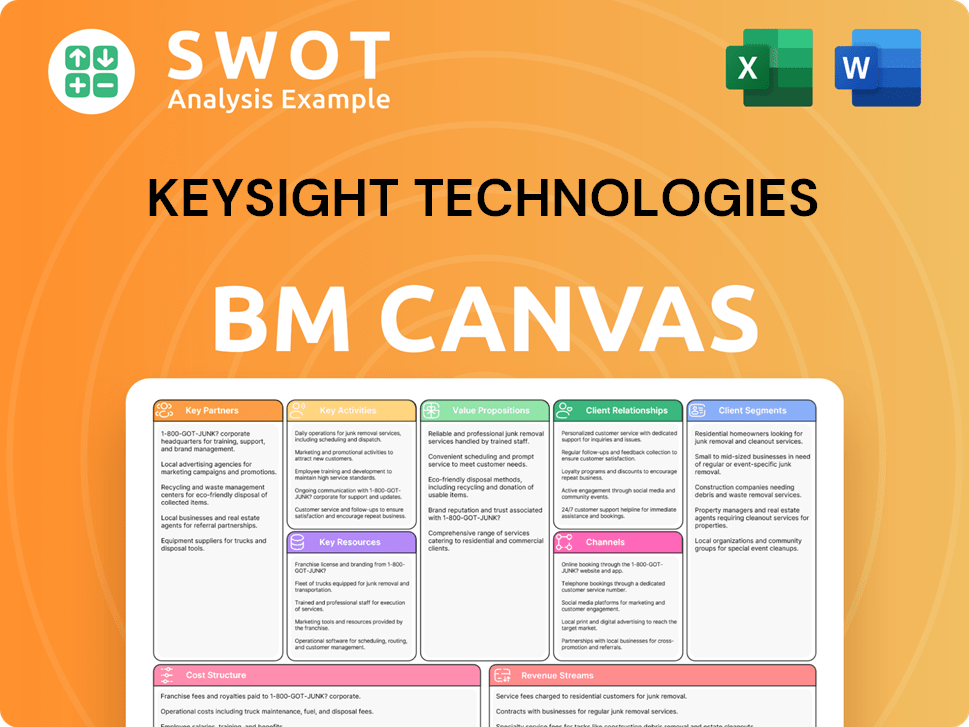
What Recent Changes Have Shaped Keysight Technologies’s Ownership Landscape?
Over the past few years, the Keysight Technologies ownership structure has shown a strong presence of institutional investors. As of June 2025, these investors collectively hold a significant portion of the company's shares, with ownership ranging from approximately 73.62% to over 93%, depending on the specific data source and reporting date. This high level of institutional ownership indicates a continued confidence from major financial entities in Keysight Technologies.
Recent strategic moves, such as the acquisition of Spirent in 2024 for $1.5 billion, expected to close by April 2025, highlight Keysight's proactive approach to market dynamics. As part of the acquisition, Keysight is divesting Spirent's high-speed Ethernet and network security business lines to meet regulatory requirements. This strategic action aligns with industry trends of consolidation and expanding solution portfolios to meet evolving technological demands, such as 5G, AI, and 6G. The company's sustained investment in R&D, along with the growth in software and services revenue, and annual recurring revenue reaching approximately $1.5 billion, or 30% of total revenue in fiscal year 2024, further solidifies its position.
| Metric | Value | Year |
|---|---|---|
| Trailing 12-Month Revenue | $5.11 billion | April 30, 2025 |
| Software and Services Revenue | Growing | 2024 |
| Annual Recurring Revenue | $1.5 billion (30% of total revenue) | Fiscal Year 2024 |
While insider ownership remains relatively low, the consistent institutional accumulation suggests a stable investment for large funds. The shift towards a software-centric solutions strategy and increased recurring revenue streams is a notable trend. For more detailed insights into the company, you can explore the Keysight Technologies company profile.
Institutional investors hold a dominant position in Keysight Technologies, with ownership ranging from approximately 73.62% to over 93% as of June 2025.
Keysight acquired Spirent for $1.5 billion in 2024, demonstrating strategic moves to expand its portfolio and adapt to market demands.
Keysight reported a trailing 12-month revenue of $5.11 billion as of April 30, 2025, with significant growth in software and services revenue.
Annual recurring revenue reached approximately $1.5 billion, or 30% of total revenue in fiscal year 2024, showing a shift towards a software-centric model.
Keysight Technologies Porter's Five Forces Analysis
- Covers All 5 Competitive Forces in Detail
- Structured for Consultants, Students, and Founders
- 100% Editable in Microsoft Word & Excel
- Instant Digital Download – Use Immediately
- Compatible with Mac & PC – Fully Unlocked
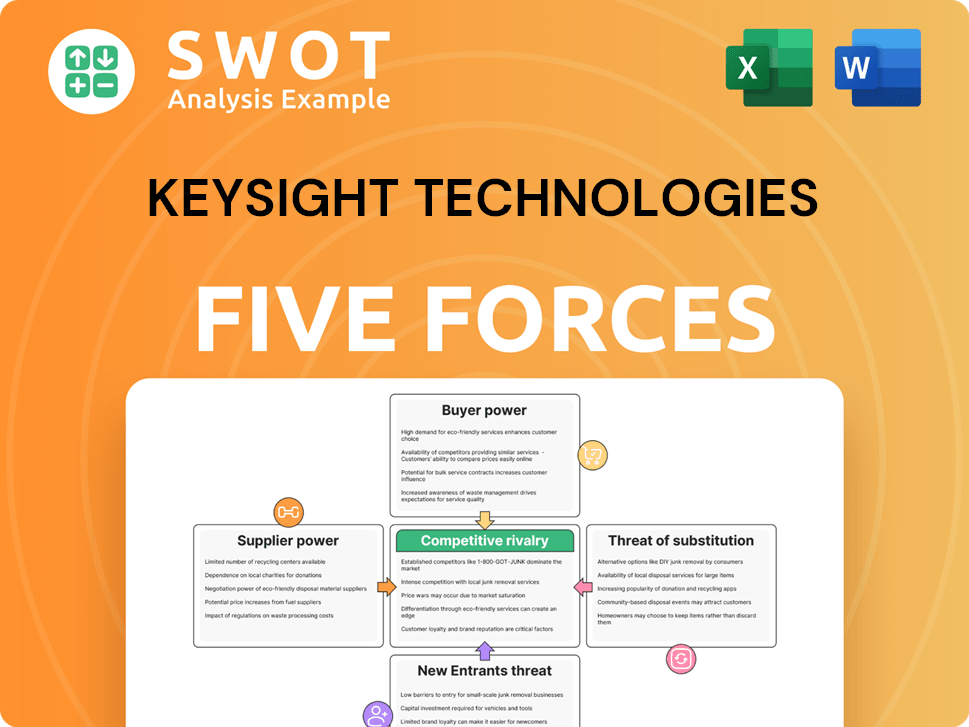
Related Blogs
- What are Mission Vision & Core Values of Keysight Technologies Company?
- What is Competitive Landscape of Keysight Technologies Company?
- What is Growth Strategy and Future Prospects of Keysight Technologies Company?
- How Does Keysight Technologies Company Work?
- What is Sales and Marketing Strategy of Keysight Technologies Company?
- What is Brief History of Keysight Technologies Company?
- What is Customer Demographics and Target Market of Keysight Technologies Company?
Disclaimer
All information, articles, and product details provided on this website are for general informational and educational purposes only. We do not claim any ownership over, nor do we intend to infringe upon, any trademarks, copyrights, logos, brand names, or other intellectual property mentioned or depicted on this site. Such intellectual property remains the property of its respective owners, and any references here are made solely for identification or informational purposes, without implying any affiliation, endorsement, or partnership.
We make no representations or warranties, express or implied, regarding the accuracy, completeness, or suitability of any content or products presented. Nothing on this website should be construed as legal, tax, investment, financial, medical, or other professional advice. In addition, no part of this site—including articles or product references—constitutes a solicitation, recommendation, endorsement, advertisement, or offer to buy or sell any securities, franchises, or other financial instruments, particularly in jurisdictions where such activity would be unlawful.
All content is of a general nature and may not address the specific circumstances of any individual or entity. It is not a substitute for professional advice or services. Any actions you take based on the information provided here are strictly at your own risk. You accept full responsibility for any decisions or outcomes arising from your use of this website and agree to release us from any liability in connection with your use of, or reliance upon, the content or products found herein.